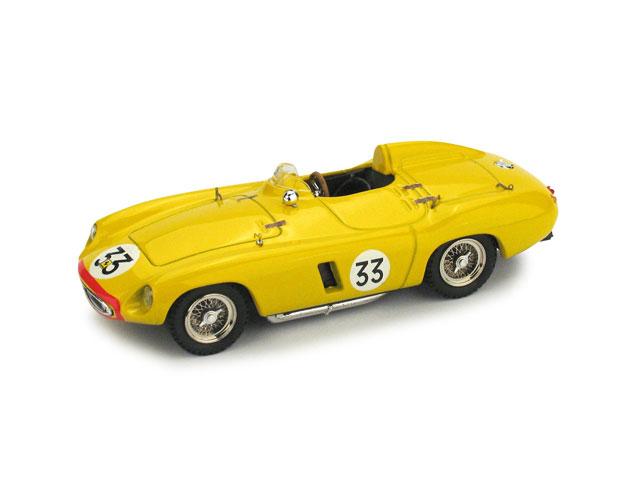|
Ecurie Francorchamps official collection
|
|
 |
|
|
EF14 Limited edition 500pcs. Prodotto da / manufactured by M4 srl |
|
|
EF14 FERRARI 750 MONZA SPYDER SCAGLIETTI ( telaio/chassis 0552 )
Non tutte le Ferrari hanno dodici cilindri. Così si potrebbe intitolare il paragrafo dedicato alla 750 Monza Spyder Scaglietti. Il quattro cilindri Ferrari, inizialmente di due litri di cilindrata, è stato progettato dall’ingegner Aurelio Lampredi nell’arco di una domenica, su richiesta dello stesso Ferrari, non appena viene resa nota la cilindrata per le vetture formula del campionato 1952-53. Il debutto in corsa del nuovo propulsore avviene a Bari il 2 settembre del 1951, dove con Piero Taruffi alla guida si classifica al terzo posto. Nel biennio 52-53 il modello 500 F2 (dove 500 è la cilindrata unitaria) spopola con Antonio Ascari riportando due Campionati del Mondo. Già nel 1953 questa unità motrice, portata a due litri e mezzo di cilindrata, e come tale denominata 625, viene installata in vetture sport; quindi ulteriormente evoluta in 735 e poi in 750 per complessivi tre litri. Nel 1955 Jacques Swaters corre come Equipe Nationale Belge, nata dalla fusione della sua Ecurie Francorchamps con l’Ecurie Belge di Johnny Claes. L’8 maggio ha luogo sul Circuito di Spa il 6° Gran Premio per vetture di serie e due gialle 750 Monza sono della partita: quella con telaio 0552 e numero di gara 33 per lo stesso Swaters, un'altra con telaio 0518 e numero di gara 34 per Roger Laurent. La gara vede Paul Frère con una Aston Martin DB3S sul gradino più alto del podio, seguito dalle gialle vetture belghe in ordine… di numero. Dopo averle usate in molte corse internazionali e locali, le due gialle sport a motore quattro cilindri sono state rimpiazzate da modelli più recenti e performanti; la 0552, sinistrata, è stata rimpiazzata dalla prima 500 Testa Rossa telaio 0600 il 20 febbraio del 56, mentre la 0518, vissuta, è stata sostituita dalla 500 TRC telaio 0682 il 2 febbraio del 57. Entrambe calcano ancora occasionalmente i circuiti e le strade del mondo, amorevolmente mantenute dai loro attuali proprietari. ( GB ) Not all Ferrari cars have twelve cylinders. This could well be the title for a write-up dedicated to the 750 Monza Spyder Scaglietti. The 4-cylinder Ferrari, initially a two-litre model, was designed by Aurelio Lampredi in the space of one Sunday as requested by Ferrari himself, just as soon as the engine capacity for cars in the 1952-53 championship were announced. The race debut for the new power unit was in Bari on September 2, 1951, where Piero Taruffi drove to third place. In the two years 1952-53 the 500 F2 model (where 500 stands for the cylinder unit capacity) with Antonio Ascari was unbeatable and won two World Championships. Already in 1953 this engine, by that time increased to two and a half litres and so named the 625, was installed on sports cars; then it was further developed to a 735 and, later, a 750 version for a total engine capacity of three litres. In 1955 Jacques Swaters raced as Equipe Nationale Belge, a team formed after the merger of his Ecurie Francorchamps with Johnny Claes' team, Ecurie Belge. On May 8th the 6th Grand Prix for production cars took place at the Spa circuit and two yellow 750 Monza cars were in the line-up: one with chassis 0552 and race number 33 driven by Swaters himself, the other, with chassis 0518 and race number 34, with Roger Laurent at the wheel. The race saw Paul Frère with an Aston Martin DB3S take the highest step on the podium, followed by the two yellow Belgian cars in race number order. After using them in many local and international events the two yellow, 4-cylinder engine sports cars were replaced by more recent, higher performance models. The 0552, which was damaged, was replaced by the first 500 Testa Rossa, chassis number 0600, on February 20, 1956, while the 0518, a survivor, was replaced by the 500 TRC with chassis 0682 on February 2, 1957. Both still occasionally make outings on world circuits and roads, lovingly maintained by their current owners. |
|
